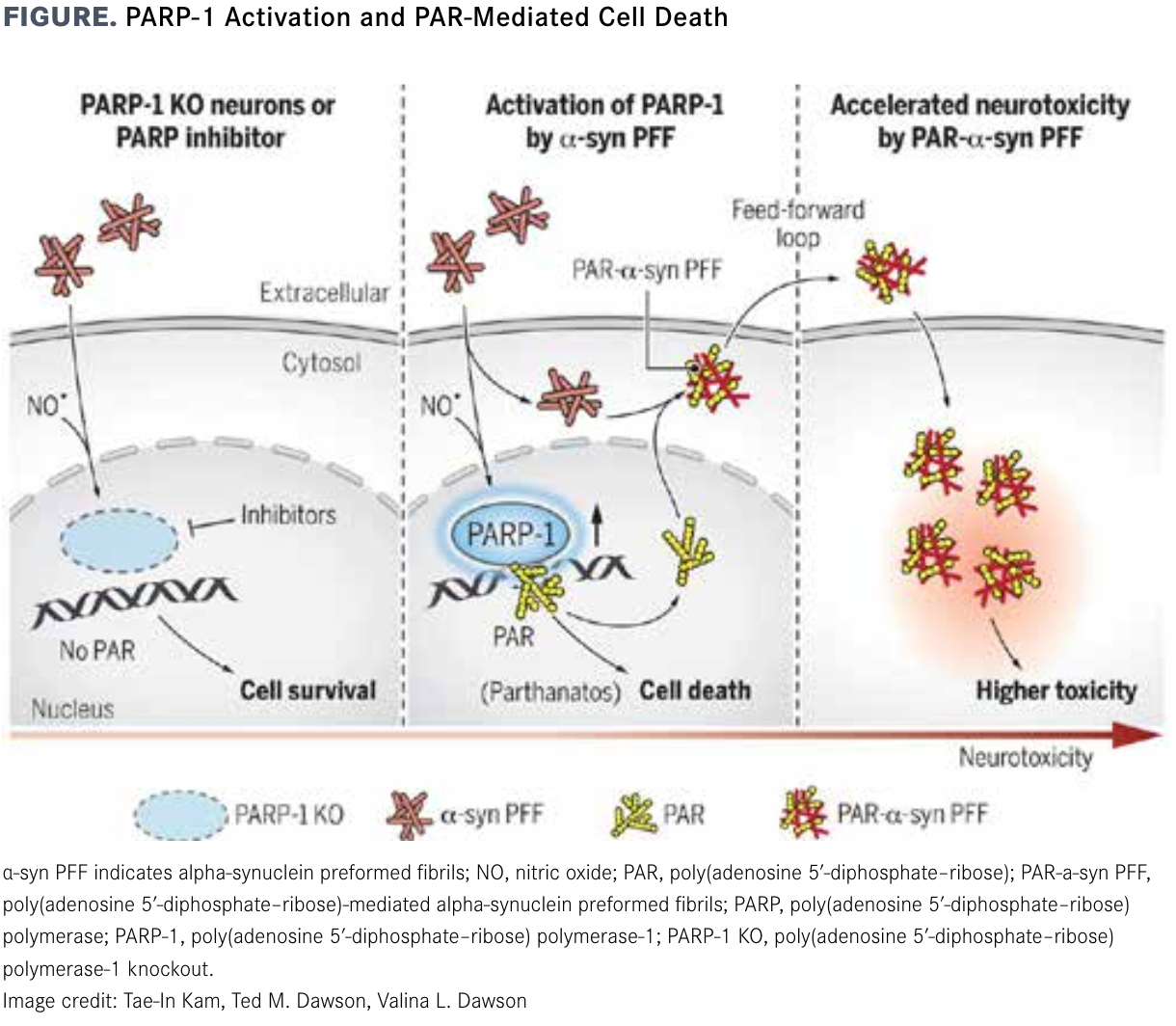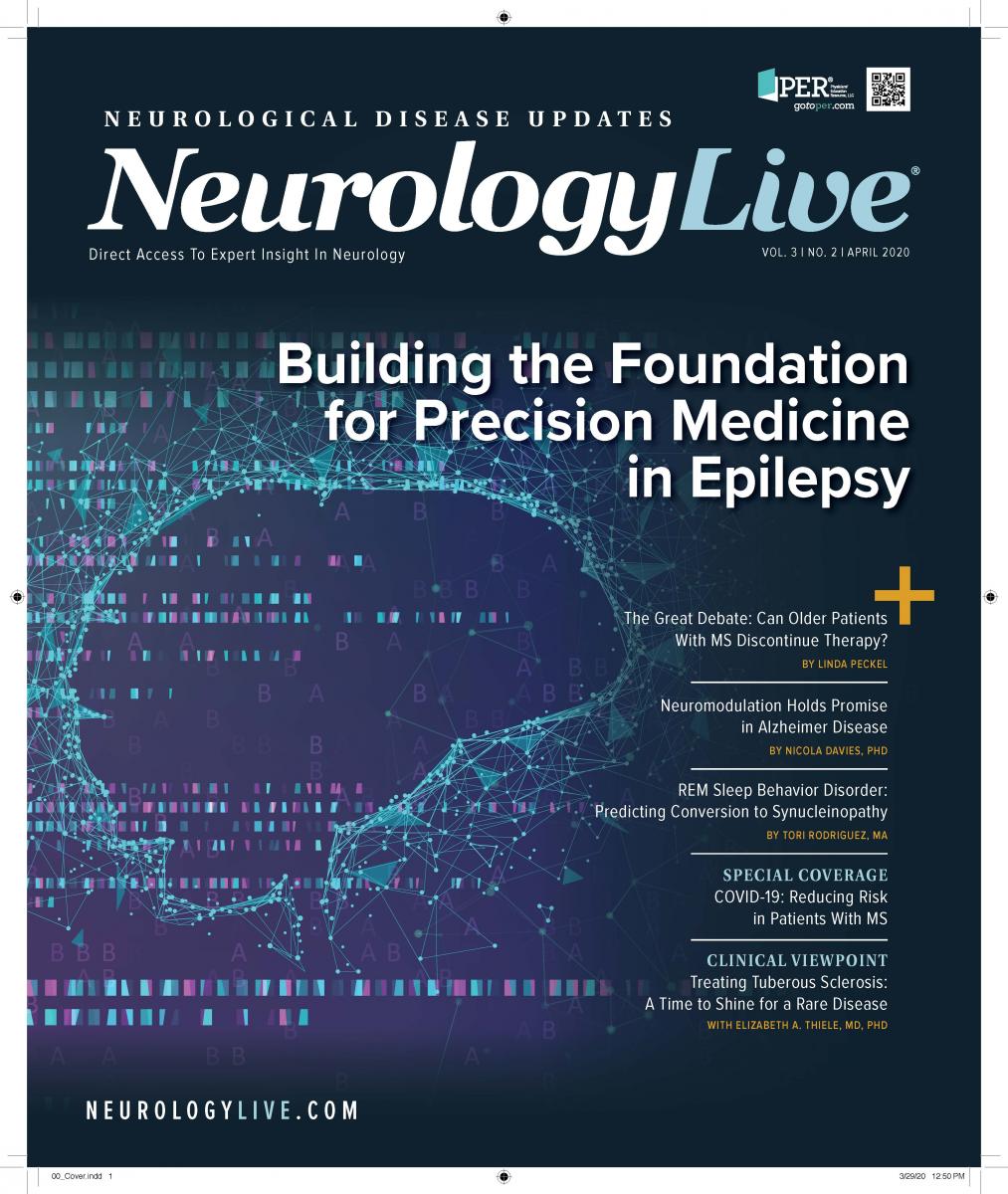Publication
Article
NeurologyLive
PARP Pathway May Hold Promise for Parkinson Disease Treatment
Author(s):
Examining the underlying roles of poly adenosine diphosphate-ribose (PARP) play in the neurodegeneration of Parkinson disease.

Therapies for patients with Parkinson disease (PD) have long focused on the symptomatic management of this neurodegenerative movement disorder, namely by compensating for the loss of dopamine in the brain.1,2 Loss of dopaminergic neurons in the substantia nigra pars compacta, a hallmark of PD, is promoted by the pathologic accumulation of aggregated α-synuclein protein, resulting in the disease’s characteristic motor symptoms: rigidity, tremor, and slowed movement. Accumulation of α-synuclein alsoaffects other neuronal systems, accounting for the nonmotor symptoms often observed in patients with PD, such as autonomic dysfunction, anxiety, depression, and sleep disorders.1,3
Although the immediate cause of PD pathology—toxic aggregation of α-synuclein and the resultant neuronal death—is clear, many questions remain about the underlying mechanisms that drive this process. Kam et al provided new insights into those mechanisms in a 2018 article detailing the roles of poly—(adenosine diphosphate [ADP]-ribose) (PAR) and PAR polymerase (PARP), specifically the PARP-1 isoform, which functions as a DNA damage repair protein.3
As a family of enzymes that catalyze ADP-ribosylation, or the transfer of ADP-ribose to protein substrates, PARPs are well known for their role in DNA repair. However, they also play roles in several cellular processes, including cell death. The PARP family includes at least 18 members. PARP-1, the best characterized, helps regulate cellular homeostasis and preserve genomic stability.4,5 Most cellular substrates of PARP are nuclear proteins involved in nucleic acid metabolism, modulation of chromatin structure, DNA synthesis, and DNA repair.4 In the presence of mild DNA damage, PARP-1 displays up to 500-fold—increased activity and uses oxidized nicotinamide adenine dinucleotide to synthe-size PAR polymers, which it adds to proteins as part of the DNA base-excision repair process.5 In cases of more significant DNA damage, PARP-1 becomes hyperactivated and produces long-chained, branched PAR polymers. The ensuing series of events, including large-scale DNA fragmentation and chromatin condensation, culminates in cell death.5
This type of cell death, known as parthanatos, is a unique process, distinct from apoptosis and necrosis. Parthanatos is the result of rapid activation of PARP-1, which leads to accumulation of PAR polymer, mitochondrial depolarization, and nuclear translocation of apoptosis-inducing factor.5,6 In their study, Kam et al found that a synthetic form of aggregated α-synuclein activated nitric oxide synthase, resulting in DNA damage, activation of PARP-1, and ultimately cell death via parthanatos (FIGURE).

Research demonstrating increased PARP activity in the presence of DNA-damaging treatments, especially some chemotherapeutic agents and radiation, elucidated the role of PARPs in DNA repair. In fact, chemotherapy resistance in tumor cells has been tied to the upregulation of DNA repair mechanisms. These observations led to the development of PARP inhibitors, which have been used to treat various types of cancer, including tumors exhibiting chemo-therapy resistance, upregulated PARP activity, or reliance on PARP-mediated DNA repair because of defects in genes such as BRCA.4
Kam et al employed PARP inhibitors in their study and used α-synuclein preformed fibrils (PFFs), an aggregated form of recombinant α-synuclein generated in vitro that is structurally similar to the endogenous form observed in PD, to better understand the drivers of α-synuclein aggregation and, in turn, cell injury and death in PD.3 After adding α-synuclein PFF to cultured cortical neurons, the investigators used a specific and sensitive anti-PAR monoclonal antibody to measure PAR levels. The results revealed that PFF administration led to PARP activation, which peaked between 3 and 7 days and remained elevated for up to 14 days. Additionally, PAR elevation was accompa-nied by neuronal death. Kam et al then treated cultured neurons with 3 PARP inhibitors, ABT-888 (veliparib), AG-014699 (rucaparib), and BMN 673 (talazoparib); the latter 2 are currently FDA approved for the treatment of BRCA-mutated breast cancer.7 As a result, α-synuclein PFF-mediated PARP activation and cell death were prevented. Notably, the PARP inhibitors also reduced phosphorylation and aggregation of α-synuclein, processes associated with α-synucleinopathy pathology.
In addition, deletion or knockout of PARP-1 prevented α-synuclein PFF-mediated PARP activation and, in turn, parthanatos. Notably, the investigators reported that treatment with a broad-spectrum caspase inhibitor partially reduced PFF toxicity; however, use of necroptosis and autophagy inhibitors had no impact. Further investigation demonstrated that knockout of PARP-1 reduced the trans-mission of toxic α-synuclein between neurons; such transmission is observed both experimentally (with PFF) and in patients with PD, in which it contributes to the pathogenesis of the disease.3 In vivo assays involving PFF injection into mouse brains produced results consistent with the in vitro data. Furthermore, PFF injection caused neuro-degeneration; the number of dopaminergic neurons in the mouse brain was reduced by 50% at 6 months post treatment, an effect miti-gated by PARP inhibitor administration or prevented by PARP-1 knockout. Finally, the investigators generated a PAR-modified form of α-synuclein PFF by coincubating recombinant α-synuclein and PAR. This PAR-modified PFF proved particularly toxic, with accelerated α-synuclein fibril formation in biochemical assays, enhanced α-synuclein aggregation in cultured neurons, and an accelerated disease course in injected mouse brains compared with unmodi-fied PFF. In what Kam et al described as a “feed-forward loop,” PAR addition was found to enhance the neurotoxicity and cellular transmission of α-synuclein both in vitro and in vivo.3 When examining human cohorts, the investigators found increased levels of PAR in the cerebrospinal fluid and brains of patients with PD, further suggesting a role of PARP activation in the pathogenesis of this disease.3
“Strategies aimed at inhibiting PARP-1 activation could hold promise as a disease-modifying therapy to prevent the loss of DA [dopaminergic] neurons in PD and related α-synucleinopathies,” the authors concluded, adding that PAR levels in cerebrospinal fluid may be particularly useful as biomarkers of therapeutic benefit in the development of disease-modifying therapies for PD and other neurodegenerative diseases.3
REFERENCES
1. Dickson DW. Parkinson’s disease and parkinsonism: neuropathology. Cold Spring Harb Perspect Med.2012;2(8). doi: 10.1101/cshperspect.a009258
2. Charvin D, Medori R, Hauser RA, Rascol O. Therapeutic strategies for Parkinson disease: beyond dopami-nergic drugs [erratum in Nat Rev Drug Discov.2018;17(11):844. doi: 10.1038/nrd.2018.184]. Nat Rev Drug Discov. 2018;17(11):804-822. doi: 10.1038/nrd.2018.136
3. Kam TI, Mao X, Park H, et al. Poly(ADP-ribose) drives pathologic α-synuclein neurodegeneration in Parkinson’s disease. Science. 2018;362(6414). doi: 10.1126/science.aat8407
4. Morales J, Li L, Fattah FJ, et al. Review of poly (ADP-ribose) polymerase (PARP) mechanisms of action and rationale for targeting in cancer and other diseases. Crit Rev Eukaryot Gene Expr. 2014;24(1):15-28. doi: 10.1615/critreveukaryotgeneexpr.2013006875
5. Fatokun AA, Dawson VL, Dawson TM. Parthanatos: mitochondrial-linked mechanisms and therapeutic opportunities. Br J Pharmacol. 2014;171(8):2000-2016. doi: 10.1111/bph.12416
6. Berger NA, Besson VC, Boulares AH, et al. Opportunities for the repurposing of PARP inhibitors for the therapy of non-oncological diseases. Br J Pharmacol. 2018;175(2):192-222. doi: 10.1111/bph.13748
7. Mweempwa A, Wilson MK. Mechanisms of resistance to PARP inhibitors - an evolving challenge in oncology. Cancer Drug Resist. 2019;2:608-617. doi: 10.20517/cdr.2019.50.






